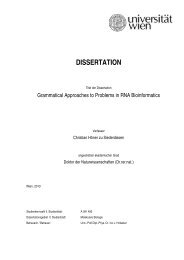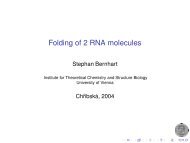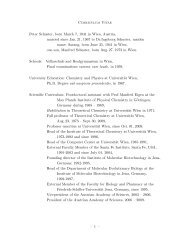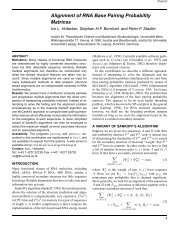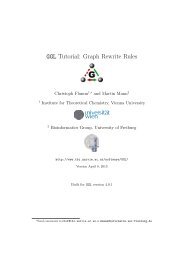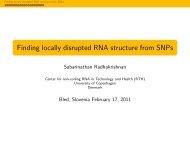A Toy Model of Chemical Reaction Networks - TBI - Universität Wien
A Toy Model of Chemical Reaction Networks - TBI - Universität Wien
A Toy Model of Chemical Reaction Networks - TBI - Universität Wien
You also want an ePaper? Increase the reach of your titles
YUMPU automatically turns print PDFs into web optimized ePapers that Google loves.
Chapter 7<br />
Conclusion and Outlook<br />
The present <strong>Toy</strong> <strong>Model</strong> is at least close to a minimal implementation <strong>of</strong><br />
an artificial chemistry exhibiting what we consider the defining features <strong>of</strong><br />
“real” chemistry. Molecules were represented only by their connectivity information<br />
and atom types, as labeled graphs, and their energy was defined<br />
along the lines <strong>of</strong> quantum chemistry, using an extremely simplified function.<br />
This energy model forms the basis <strong>of</strong> full-fledged chemical thermodynamics<br />
and kinetics. <strong>Chemical</strong> reactions are implemented as graph rewriting rules<br />
that have to obey the principle <strong>of</strong> conservation <strong>of</strong> matter. These features<br />
distinguish the <strong>Toy</strong> <strong>Model</strong> from artificial chemistries that are defined on abstract<br />
algebraic structures such as the λ calculus, Turing machines, or term<br />
rewriting. The application <strong>of</strong> the model to examples <strong>of</strong> complex organic and<br />
prebiotic chemistry allowed an quasi-ab initio simulation <strong>of</strong> the resulting<br />
networks and prediction <strong>of</strong> their properties. Now the emergence <strong>of</strong> generic<br />
properties <strong>of</strong> CRNs can be studied given only starting material, generic reactions<br />
and atom and bond parameters. A true ab initio simulation would not<br />
need the introduction the latter parameters for the energy calculation and<br />
would simulate reactions without even specifying generic reactions. Yet both<br />
“educated guesses” are founded on the results <strong>of</strong> quantum chemistry and<br />
synthetic chemistry, and their validity could be estimated by the judicious<br />
comparison <strong>of</strong> predicted to experimental results.<br />
A number <strong>of</strong> extensions <strong>of</strong> the present <strong>Toy</strong> <strong>Model</strong> are desirable. For<br />
instance, the addition <strong>of</strong> the corresponding parameters (see appendix A)<br />
would extend the current implementation <strong>of</strong> the model, considering only<br />
molecules composed <strong>of</strong> C, H, O, and N, to an expanded set <strong>of</strong> chemical<br />
elements, most importantly S, P, Si, and the halogens. The inclusion <strong>of</strong><br />
charged particles and radicals also does not seem to pose problems in the<br />
current framework. Charges situated on specific atoms can be indicated in<br />
SMILES, e.g. HC([O−]) = O. In fact, it does not matter to which atom the<br />
55







